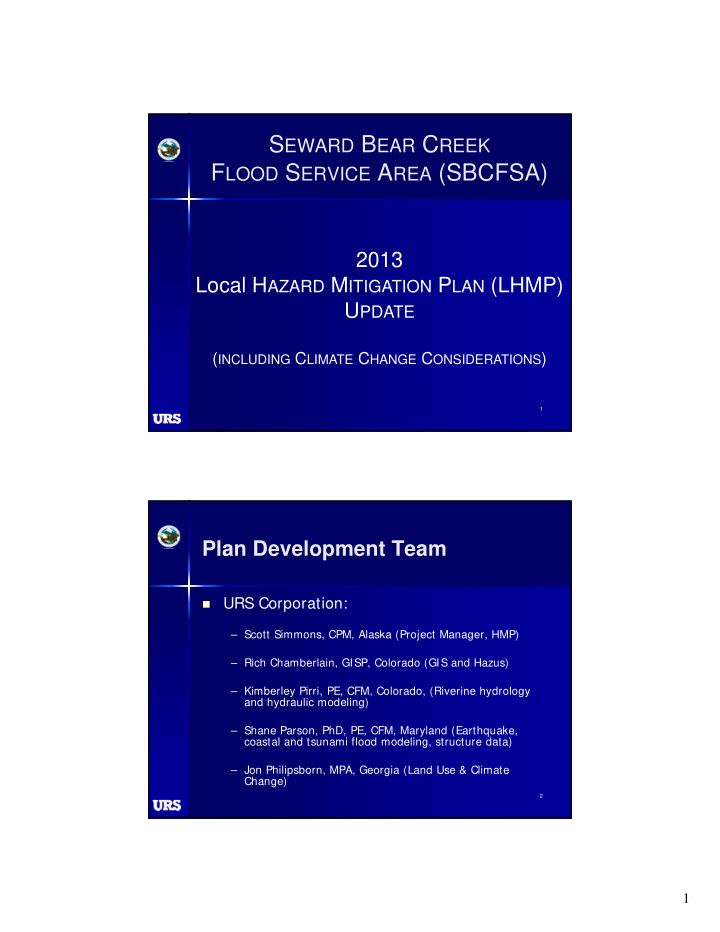



S EWARD B EAR C REEK F LOOD S ERVICE A REA (SBCFSA) 2013 Local H AZARD M ITIGATION P LAN (LHMP) U PDATE ( INCLUDING C LIMATE C HANGE C ONSIDERATIONS ) 1 Plan Development Team URS Corporation: – Scott Simmons, CPM, Alaska (Project Manager, HMP) – Rich Chamberlain, GISP, Colorado (GIS and Hazus) – Kimberley Pirri, PE, CFM, Colorado, (Riverine hydrology and hydraulic modeling) – Shane Parson, PhD, PE, CFM, Maryland (Earthquake, coastal and tsunami flood modeling, structure data) – Jon Philipsborn, MPA, Georgia (Land Use & Climate Change) 2 1
FEMA HMP Development Process 3 FEMA HMP Development Process (Continued) 4 2
The “Typical” HMP Update Process FEMA requires a complete LHMP review to identify needed updates and status of proposed implementation activities – Identify unlisted current LHMP Hazards that threaten the SBCFSA – Determine the Risks from each new and existing hazard – Develop Planning Goals for the SBCFSA – Determine status of prior selected and implemented actions and projects – Develop new, or refine existing, mitigation Programs, Actions, and/or Projects The SBCFSA LHMP was converted from a Flood Hazard Plan to a LHMP – Needs only to be reviewed and annexed by the Borough for inclusion within their Multi-Jurisdictional HMP 5 The SBCFSA LHMP Development Process Described SBCFSA’s recurring hazards and their impacts Analyzed known hazards in addition to flood Defined SBCFSA’s infrastructure risks Defined critical facilities’ vulnerability to each hazard Developed mitigation goals – (focuses mitigation action development) Developed Mitigation Strategy – (defines methods to reduce damages) Reviewed potential project list and selected the most beneficial actions or projects – (best approach to reducing or avoiding damage to facilities or infrastructure) Developed plan maintenance (reviewed and updated strategies) – (guides the update process; assures adding the most current information) 6 3
Hazards Profiled Earthquake – Hazus Modeling Erosion Flood (Riverine, Coastal) – Hazus modeling Ground Failure (Avalanche, Landslide, Subsidence, Unstable Soils) Severe Weather Tsunami and Seiche – Hazus modeling Volcanic Hazards Wildland-Urban Interface Fire 7 8 4
Flood Modeling Considerations Lessons learned from September site visit during active flood event – Flooding over Seward Highway and Nash Road – Box Canyon Creek split flow – Lowell Point access issues from Lowell Creek Tunnel flow – Floodwaters with high levels of debris from glacial deposits – Estimated typical height above grade for different foundation types Used existing FEMA preliminary flood models where available USACE provided Lowell Creek modeling data Developed structure-specific database to allow detailed flood loss analysis Used existing coastal flood and tsunami modeling Considered potential climate change and land use changes 9 Climate Change Considerations Objective: “Understand threat of climate change to appropriately identify mitigation and adaptation alternatives” Process: Researched best available climate change science Used downscaled climate data from UAF – (precipitation and temperature) Key findings: Total Annual Precipitation will increase within KPB and SBCFSA Average Annual Temperature will increase within KPB and SBCFSA Every watershed within SBCFSA is subject to increased flow rates 10 5
Land Use Change Objective: “Comprehend future development needs in order to sustainably grow” Process: Researched existing “development” plans and other available information Contacted relevant subject-matter-experts at SBCFSA, City of Seward, and KPB Key findings: Majority of potential development would be single-family residential north of City of Seward • Seward Marine Industrial Center ( SMIC) Development main exception Potential development slated to occur in areas currently and/or potentially (future scenarios) impacted by flood and other hazards 11 Flood Results Greatest losses likely to occur along Salmon Creek – For current and future models Most problematic area along Seward Highway and Nash Road where: – Clear Creek, Salmon Creek, and Resurrection River floodplains all intersect Box Canyon Creek affects Clear Creek – Floods on Clear Creek due to levee failure on Box Canyon Creek are more damaging than floods from only Clear Creek drainage Extension of coastal floodplain to Lowell Point – Found significant potential losses High losses in downtown Seward – If Lowell Creek Tunnel is blocked Severe Tsunami losses – To all low-lying areas 12 6
Climate Change & Predicted Future Land Change Results Impacts of Climate Change: Current day 100-yr flood event could be future 10- or 50-year event Additional impacts beyond flooding (fire, landslides, etc.) - Potential impact on tourism and/or economic aspects (fishing) not addressed in this study Development Decisions Future development should consider current flooding - Also consider potential future flood events True for all development and infrastructure - Not just housing 13 Mitigation Strategy A Comprehensive Risk Assessment is Essential Establish Mitigation Goals – Defines what SBCFSA desires to accomplish Identify the Most Effective Projects – Good projects will reduce future damage Prioritize – Projects listed in the order that is most important for the SBCFSA to reduce or eliminate the worst repeated damages 14 7
Mitigation Recommendations Promote recognizing and mitigating all natural hazards that affect the SBCFSA. Reduce loss and damage possibility from all natural hazards that affect the area. Cross reference mitigation goals and actions with other partners’ planning mechanisms and projects. Reduce structural vulnerability to earthquake, erosion, flood, ground failure, severe weather, tsunami, volcano, and wildland fire damages. Consider future climate change and potential impact on hazards in SBCFSA during future planning and development decisions. 15 Questions? URS Corporation Scott Simmons, scott.simmons@urs.com Toll-free: 800.909.6787 Office: 907.433.6700 Direct: 907.433.6711 16 8
Recommend
More recommend